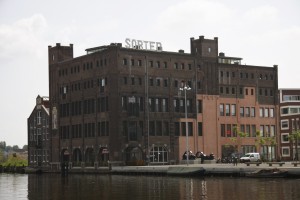or Dynamic Relations in an Urban Landscape…
Considering people, I would say relations between them are always dynamic. When I talk about relations I talk in the broader sense of relations. Every interaction between people is build upon a sort of relation. In traffic, we have a lot of relations between people.
On the highway for example if somebody crashes his or her car, this can end up blocking the whole highway and creating a huge traffic jam.The people in the traffic jam will be late for work and so this will have effect on their colleagues, who would have been in a meeting with them. Of course a small example.
In city life, urban landscapes, we have to deal a lot with all sorts of relations between people. We deal with big grids of infrastructure, where we all make use of.
In an urban setting, there are places which are a kind of non-places. Transit area’s where people tend to pass by and keep on moving. Crossings where different kinds of traffic and time-lines pass. These spaces are also called ‘Hybrid spaces’ (by Saskia Sassen). ‘Hybrid space’ means that there is more than one purpose for the area, but no one really takes claim on the responsibility of that space.
These spaces have more than one user. For example highway cross-overs, where also bicycle paths cross. During weekdays, on the mornings, on top there could be a traffic jam, of all the people going to work. But underneath all the children pass with bikes to go to school. But also the old guy that walks his dog. And the metro, that passes over the cross-over. Different time-lines crossing over the same spot.
A video I made on this subject a few years ago:
I do admit I am intrigued by this situations. They are a sort of vacuum where things happen. Sometimes when traveling (not on a touristy way), one can find himself in a kind of a similar situation, where you end up in a sort of vacuum. A vacuum between culture, language, perception, life style and a lot more. Sometimes you can feel a tense atmosphere and you don’t know what will happen. Will things happen? Who is in charge? Is there a way out? You end up somewhere with a feeling that you are out of control..
The ‘Nieuwe Vide’ in Haarlem provides, within their yeargoing theme ‘The Object Lag’, the Negotiating Equity group with a platform for the projects. I was asked to create an event in the context of the day of the architecture and in the context of the neighborhood.
Together with David van der Veldt and Tabo Goudswaard we ran a project called:
SORTED or get sorted...
The neigborhood in question was the former Harmenjanswijk in Haarlem. Now the name of the neighborhood is changed into Sportheldenbuurt and the houses are renewed. The ‘old’ neighborhood inhabitants where moved out of th eneighborhood and after the renewal of the houses most of them moved back into their neighborhood.
On the former industrial area luxurious studio’s and apartments where build. This industrial area used to be the Droste-factory. The Droste-factory is an former chocolate factory, which binded the Harmenjansbuurt together.
In our very short research we found out that the integrating which the developers like to happen don’t really hit it off in the neighborhood. There seems to be a push for gentrification, but it doesn’t seem to work. The Kick Smitweg seems to be an invisible border in the neighborhood, which divides the area in 2. But then there is also the former energy factory, which is a designated cultural area, which is also quite isolated from the neighborhood. We walked around in the area and spoke to some people from the area. In the end the situation looks a bit like a mexican standoff.
After negotiations with the house owners in the Droste building we came to an agreement which made it possible for us to temporarily ‘reenact’ the old DROSTE logo, but with the letters rearranged into SORTED.
sort·ed, sort·ing, sorts (Wikipedia)
1. To arrange according to class, kind, or size; classify.
2. To separate from others: sort out the wheat from the chaff.
3. To clarify by going over mentally.
(both photo’s by Emilio Moreno).
To open up this action to the public to react, we also invited the neighborhood inhabitants for a real neighborhood barbecue. The barbecue was scheduled also as the ‘closing party’ of the Day of the Architecture in Haarlem.
This is a registration of the neigborhood barbecue (and this was also my broadcast on Salto TV).



[...] research for the Object Lag’s most recent module ‘The Archealogy of Autonomy’. Eelco Wagenaar will make a presentation entitled Sorted (or get sorted) together with David van der Veldt and Tabo [...]